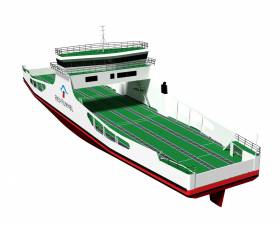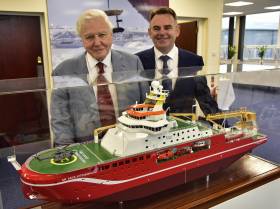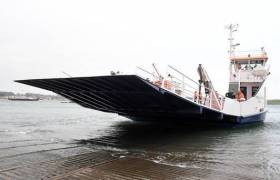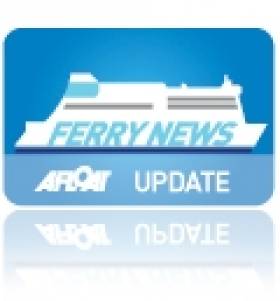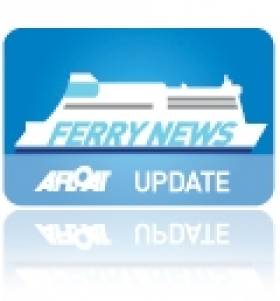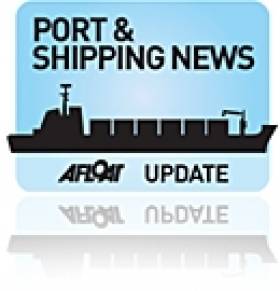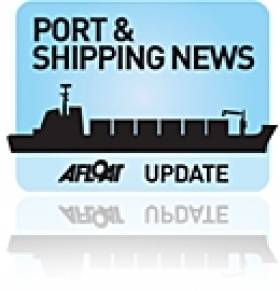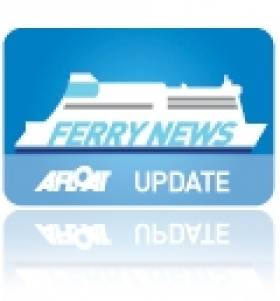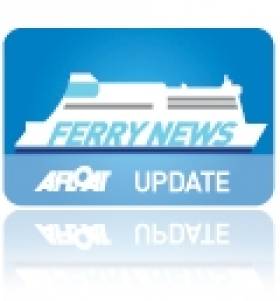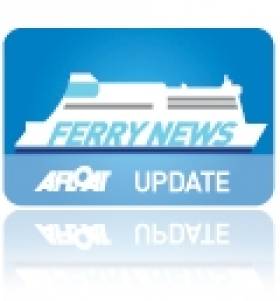Displaying items by tag: Cammell Laird
Irish Sea Shipyard to Build Isle of Wight 'Freight' Ferry
#FerryNews - An Irish Sea shipbuilder, Cammell Laird, Birkenhead on Merseyside, has been contracted to build a £10m ro-ro 'freight' ferry for a Isle of Wight operator, Red Funnel
The new ship according to a Red Funnel announcement, is designed to provide additional year-round freight capacity for the Southampton-East Cowes route. The service currently handles 53% of all freight movements across the Solent.
At 74m in length, she will provide 265 lane metres of roll-on/roll-off freight capacity and will carry up to 12 passengers. To minimise the environmental footprint, the hull shape has been designed specifically to reduce wash and a propulsion package has been selected to make her highly fuel efficient whilst meeting the latest Tier III emission regulations. The use of proven azimuth thrusters supplied by Rolls Royce, will also make the ship very manoeuvrable.
The crossing time of 55-60 minutes will be identical to Red Funnel's existing Raptor class ro-pax ships and she will use the same berths in Southampton and East Cowes.
The ship will be constructed at Cammell Laird's famous yard in Birkenhead which built the White Star passenger liner Mauretania in 1938 and HMS Ark Royal in 1955. Currently the yard is building the technically advanced polar research ship Sir David Attenborough for the British Antarctic Survey. The yard is also scheduled to deliver Red Funnel's new ferry in spring 2019.
Kevin George, Chairman and CEO of Red Funnel said "We are the number one operator for cross-Solent freight and this new ship will provide more early morning capacity on weekdays and more freight-only sailings between October and March each year. After a competitive tender, we are delighted to place our third new-build in succession with a UK yard. The order will help sustain marine manufacturing in the UK and will bring benefits to the economy of the North West and also to the Isle of Wight once she enters service."
Business Secretary Rt Hon Greg Clark MP said: "This is another vote of confidence in British shipbuilding and the excellence of our marine manufacturing sector, which we want to build on as part of our Industrial Strategy. Red Funnel continues to grow with this new investment in high quality UK manufacturing. This announcement is great news for the skilled workers at Red Funnel and Cammell Laird, and the local economies of Merseyside and the Isle of Wight".
The order for the new ship, coupled with the major refurbishment of Red Eagle and the order of Red Jet 7, amounts to an investment of over £20m in Red Funnel's cross-Solent services since the business was acquired by the consortium of UK and Canadian pension funds in July 2017. The decisions underpin the new owners' commitment to growing the cross-Solent market and helping to stimulate the Isle of Wight's economy.
#ExportDrive -UK shipbuilder Cammell Laird that is building polar research vessel Sir David Attenborough, says it plans to unleash an ‘aggressive exports drive’ in 2017 after one of its busiest years for commercial marine work, which saw it land the biggest shipbuilding project in the UK for a generation.
“Winning the Sir David has thrust the Cammell Laird brand back to where it belongs in the global super league of shipbuilding,” he said. “We won it against fierce international competition and it sends a massive message to industry about the world class skills, facilities and workforce we have here. The complex nature of the build and the polar specifications required means very few shipyards now have our experience. We fully intend to market this polar capability hard in 2017 together with our wider expertise in the ship building, conversion and repair markets. Cammell Laird is fully behind the UK Government’s desire to see British shipbuilding aggressively pursue the exports market and promote Britain as an easy place to do business post Brexit. Cammell Laird is perfectly placed to become a giant engine creating wealth and skilled jobs across academic abilities for our community and the UK economy.
"Moreover, the recommendations made by Sir John Parker in his National Shipbuilding Strategy are very astute and stand to create more opportunity for shipyards like Cammell Laird to win work particularly in the naval new build sector, where again we have considerable experience with the recent aircraft carrier programme. Success within our maritime division will in turn enable us to diversify further into multi-billion pound energy markets like nuclear, oil and gas and renewables.”
Cammell Laird managing director Linton Roberts said the total number of drydockings and repairs in 2016 was more than 150 while workforce numbers peaked at 1050 in full time and contractor positions while apprentice numbers had grown by 21 to 79. In terms of other new build work he said the Birkenhead based yard had sent the Strangford Lough ferry ‘Strangford II’ for commissioning and sea trials before being delivered to her owners the Northern Ireland Executive at the beginning of October.
Mr Roberts said the range of the ships and breadth of work undertaken reinforced the capabilities within the company. He said Cammell Laird has undertaken repair and routine drydockings for a number of RoRo and RoPax customers including P&O Ferries, Stena Line, Seatruck Ferries, Irish Ferries, the Isle of Man Steam Packet Company and Caledonian McBrayne. Ships worked on include: Clipper Ranger, Ben-My-Chree, Clansman, Finlaggen, Isle of Arran, Isle of Lewis, Loch Portain, Lochinvar, Lord of the Isles, Isle of Inishmore, Jonathan Swift, Manannan, Norbank, Norbay, European Endeavour, Stena Performer, Seatruck Progress and Seatruck Pace.
Mr Roberts said the Caledonian MacBrayne’s flagship, the 2014-built ‘Loch Seaforth’, travelled from Ullapool for an 11 day dry dock in October, followed by the ‘Lord of the Isles’ and ‘Hebridean Isles’ in November. The ‘Isle of Mull’ is scheduled for the end of November. A variety of other types of vessels have also been accommodated. The Afon Dyfrdwy Airbus wing carrier was in drydock in July, and the Amazone paid a visit for hopper door repairs in the same month. Meanwhile The ‘Galileo G’ Expedition Superyacht was an exotic visitor in May.
Mr Roberts said Cammell Laird had seen a quieter year in RFA work ahead of an expected upturn in 2017. Cammell Laird has a through-life support cluster contract to maintain nine of the 13 ships in the RFA flotilla. However, the yard did undertake a dry docking and maintenance period for the RFA Fort Rosalie between October and November.
Elsewhere Cammell Laird repaired Mersey Ferries’ Royal Iris following a grounding at the entrance to the Manchester Ship Canal, and fellow Mersey Ferries Royal Daffodil and the dazzle-painted Snowdrop were also drydocked during the year. Meanwhile, bunker tanker Mersey Spirit, hopper barge HAM 602, jack-up Irish Sea Pioneer and tug Switzer Asgarth all visited the shipyard during 2016. The historic steam tugs Daniel Adamson and Kerne departed the shipyard in the middle of the year, both centenarians having completed comprehensive rebuilds. A new visitor to Birkenhead in November was the container vessel Rachel Borchard, docking for repairs.
Mr Roberts said work outside standard drydockings and repairs included a contract for the manufacture and installation of 400t of steelwork to be fitted on board the A2SEA Sea Installer for its upcoming deployment works on the Burbo 2 wind farm extension.
“The contract represented a significant win for the company,” he said. “The project has seen the manufacture of three main structures, two of which support 12 giant wind turbine blades with the remaining structure supporting four turbine towers. A range of deck fittings have also been manufactured to enable four nacelle hubs to be transported and installed offshore. The structures were delivered in 71 days, and were fitted in a 30 day installation period, showcasing our ability to react to challenges with short lead times. It is important to emphasize our multiple manufacturing locations, which position us ideally to continue to serve the offshore wind and renewables sector.”
#Old&New – Fresh from annual dry-docking is Isle of Inishmore of Irish Ferries, that recently resumed Rosslare-Pembroke duties, writes Jehan Ashmore.
The 34,000 gross tonnage cruiseferry had undergone routine maintenance work at A&P Falmouth, Cornwall. This year marks 20 years since Isle of Inishmore made a debut in 1997 for owners, Irish Continental Group. The custom built ship firstly began operations for ICG's ferry division on the Dublin-Holyhead route.
Built by Van der Giessen-de-Noord, Krimpen aan den Ijssel, Rotterdam, Isle of Inishmore carries 2,200 passengers. This makes the cruiseferry still one of the largest in terms of capacity in northern-western Europe. In fact she carries more than that of flagship Ulysses of 1,875, though the larger 50,000 gross tonnage giant carries more cars and trucks.
Last month Isle of Inishmore had relieved Ulysses on the Dublin-Holyhead route, which saw the flagship drydock instead at Cammell Laird, Birkenhead. Currently at the Merserside facility is fastferry Jonathan Swift following completion of similar work. The craft having vacated the dry-dock shifted to the nearby wet basin.
Aside shiprepairs, Cammell Laird also build vessels including the £6.2m newbuild, Strangford II which was completed last year for the Department for Infrastructure (DfI) in Northern Ireland. In recent days reports the Belfast Telegraph, the 28 vehicle ferry finally began service on Strangford Lough following teething problems with vehicle loading ramps as previously reported.
As for Isle of Inishmore’s return to the ferry scene at Rosslare Europort (see report: Irish Rail 30th) this led to relief cruiseferry Oscar Wilde head also for Cornwall. An overhaul of the eldest fleetmember at the south-west UK shipyard will be carried out prior to taking up seasonal service to Cherbourg, France that begins on 1 March.
The fifth member of Irish Ferries fleet, the chartered-in ropax, Epsilon has in recent weeks carried out freight-only runs between Dublin and Rosslare. They have taken place in between routine rosters on weekly Dublin-Holyhead sailings. In addition the Italian flagged ropax sailings on the year-round operated Irish capital-continent connection to Cherbourg.
This morning Epsilon docked at the Normandy port. At the same time French service rival, Stena Line (albeit serving out of Rosslare) saw relief ropax Stena Nordica also make an in-bound call.
Ferry Busy Workload for Merseyside Shipyard
#FerryBusyCammell – A busy drydocking schedule of ferries calling to Cammell Laird, Birkenhead on the Mersey has seen nearly as many ferries in the first four months of 2015 as in the whole of 2014.
The demand for Cammell Laird has seen 15 ferries docked at its historic 120 acre site, which includes four drydocks, in 2015. A further three ferries are booked in for drydocking and repairs.
Cammell Laird managing director Linton Roberts said the company has undertaken the work for a range of long standing clients including Caledonian MacBrayne, Isle of Man Steam Packet Company, Irish Ferries, NorthLink Ferries, P&O Ferries and Seatruck Ferries.
"It has been a really strong year for ferry drydockings and repairs and we are keen to build on this and win more work from new and existing clients," he said. "The work we have undertaken has made full use of our drydocks which are suitable for vessels up to 40m beam. The drydockings have included conventional and high-speed vessels, in steel or aluminium. They have ranged from the 46m, 617 gross tons Mersey Ferry Snowdrop to the 209m, 50,938 gross tons Irish Ferries Ulysses.
"We have also worked on the Isle of Man Steam Packet Company's Manannan, a 96m high-speed wave piercing catamaran car ferry. Here we have applied a SigmaGlide 1290 silicone coating system in an environmentally-controlled enclosure"
To read much more on the Merseyside shipyard and marine engineering facility click HERE.
Note the above link's second photograph of Seatruck Ferries Dublin-Heysham ro-ro freight-ferry Seatruck Pace which featured on Afloat.ie with an interview of the master of the 'P' class vessel.
Cammell Laird Secure Contract to Build New Strangford Lough Ferry
#NewPortaFERRY – Cammell Laird, the Birkenhead based marine and specialist engineering company has been awarded a £5.7m project by the Northern Ireland's Department for Regional Development.
The news follows an open procurement exercise which attracted interest from shipyards across Europe.
The contract will see the firm construct a new car and passenger ferry to replace the MV Strangford operating the Strangford-Portaferry service on The Narrows at the entrance of Strangford Lough in Co. Down. The new ferry is due to be delivered by August 2016.
Mr Rob McBurney, Commercial Director of Cammell Laird, said: "We are very pleased to have been awarded the contract for the construction of the new Strangford Ferry. The company has a long tradition of ship building and we look forward to working with the Department over the coming years."
The new ferry will have capacity for 28 cars and 260 passengers and will share the ferry operation on a rotational basis with the MV Portaferry II. This will provide improved capacity and remove the need for a 7.5 tonne weight restriction that is in place when the MV Strangford is in service.
Transport Minister Danny Kennedy said: "The new ferry will replace the existing MV Strangford with a new modern ferry that has been designed specifically for this service. The new ferry will be built over the next 18 months and, when it comes into operation, will provide a more reliable and efficient ferry service.
"The Department for Regional Development currently operates a vehicle ferry service in Strangford Lough between Strangford and Portaferry with two vehicle ferries and a back-up passenger ferry. The new ferry will replace the existing MV Strangford which is over 40 years old and is approaching the end of its economically operational life."
The Department has engaged with a range of stakeholders, including the public, the Committee for Regional Development and local councils during the development of the ferry proposals.
A representative of the Department confirmed that the project team will continue to keep stakeholders informed during the construction of the new ferry.
The Minister added that good progress was also being made on the tender process for a new ferry for Rathlin. Tender documents have been issued to a shortlist of ship builders and they hope to award the contract in April.
Mersey Maritime Awards Judges ‘Overwhelmed’ by Number of Entries
#MaritimeAwards - The Mersey Maritime annual awards judges met for the first time on Thursday as organisers say they have been "overwhelmed" with the number of entries, writes Liverpool Echo.
Birkenhead-based Mersey Maritime, an umbrella organisation for the Liverpool city region's maritime, logistics and energy sectors, said it had received "strong entries" for all nine categories.
They are Business of the Year; Vocational Skills Award (individual award); SME Business of the Year; Engineering Company of the Year; Environmental Award; Supply Chain Partnership; Best Newcomer (company award); Global Reach Award; Ambassador of the Year Award.
The winners will be announced at a gala dinner on March 12. For more on this story, click HERE.
Afloat.addes that the photograph accompanying the Merseyside newspaper shows the Cammell Laird Shipyard and repair facility in Birkenhead.
Pictured in the dry dock is Irish Ferries Ulysses which as previously reported has returned to Dublin-Holyhead service. The operator's Isle of Inishmore from the Rosslare-Pembroke route is currently taking her turn at the same facility for annual overhaul.
In the adjoining dry-dock to that of Ulysses, was Caledonian MacBrayne's ferry, Caledonian Isles which has since resumed the Isle of Aran's Brodick-Ardrossan service. A fleetmate, Isle of Lewis is currently undergoing work having taken the place of the Firth of Clyde ferry.
#RFArefits - Cammell Laird, the Merseyside shipyard completed a £49.5m major refit of Royal Fleet Auxiliary's Fort Victoria (A387), one of the largest vessels operated by the UK Ministry of Defence, writes Jehan Ashmore.
The 10 month refit of the 16,967dwt oiler auxiliary replenishment (AOR) vessel that includes carrying stores and ammunition, was the largest single contract for Cammell Laird in 2014 and since the yard began in 2008 its life support 'cluster' contract to maintain nine of the 13 RFA flotilla.
Already refitted at the yard the oil tanker, RFA Gold Rover (A271) which Afloat.ie reported on of her Dublin Port visit last August.
Work on the Harland & Wollf built RFA Fort Victoria was extensive and among the refit's to do list, this involved overhauling the main engines and upgrading of power generation systems that required steelwork and pipework for both fresh and salt water.
Added to this the 'Fort' class vessel launched in 1990 had the blasting of old and applying of new paint within the hull's ballast and cargo tanks and to the exterior that also included the superstructure.
Following her refit, RFA Fort Victoria made a short hop across the Mersey to Liverpool Docks and remained there for several days prior to sailing to Scottish waters.
The contract with Cammell Laird, also provides capability insertion allowing the ships to be fully integrated with the Royal Navy.
In September, RFA Diligence (A132) returned from much warmer climes for her refit period which is scheduled to be completed early next month.
Every five years the cluster contract is reviewed based on performance and value for money and the Merseyside facility was given an extension of the contract in November 2012 for a further five years to 2018.
As part of the global reach element to the contract, Cammell Laird will also deliver extensive support to the RFA fleet around the world.
Cammell's Car-Ferry Clients Meet In Neighbouring Dry-Docks
#FerriesDryDock – Irish Ferries Dublin-Holyhead main route vessel Ulysses which went off service yesterday for annual overhaul as previously reported has since docked in Birkenhead to join a Scottish ferry at Cammell Laird, writes Jehan Ashmore.
Ulysses's arrival on Merseyside involved her berthing at dry-dock no. 5 at Cammell Laird, the shipyard, maintenance and repairs facility.
At a neighbouring dry-dock to where Irish Ferries 1,875 passenger/ 1,342 car giant is to undergo overhaul maintenance is Caledonian Isles, a 1,000 passenger/110 car ferry that serves CalMac's Ardrossan-Brodick route.
Taking up Ulysses's 3 hours 15 minute sailings on Dublin route is Isle of Inishmore alongside sailings served by fast-ferry Jonathan Swift and ro-pax Epsilon. Asides her Welsh duties, Epsilon is to make her first sailing in 2015 from the Irish capital to France next Saturday.
As for CalMac operations, they transferred Hebrides, a 612 passenger ferry with space for almost 100 cars to take over Caledonian Isles 55 minute long sailings on the Ayrshire-Isle of Arran link. Hebrides, otherwise serves on the Uig - Tarbert/Lochmaddy routes.
Passengers travelling with the Scottish operator are advised to click this LINK, as ferries repositioning to other routes due to overhauls over the winter may affect journey times and connections.
Ferries Take Turns to Dry-Dock in Birkenhead
#FerriesDryDock - Stena Europe which stood in to cover Dublin-Holyhead route sailings by Stena Nordica, is currently in dry-dock at Cammell Laird, Birkenhead, writes Jehan Ashmore.
The dry-docking of the Stena Europe had already been scheduled and as previously reported is not related to the recent false alarm of a fire during a Dublin-bound sailing last week.
Likewise Stena Nordica had also dry-docked at Cammell Laird, where the ro-pax spent the last two days of November. She has since resumed her roster on the central corridor route which is also served by Stena Adventurer.
Notably, RFA Fort Rosalie (A385), the London registered Royal Fleet Auxiliary fuel replenishment tanker is also berthed at the shipbuilding and repair facility on the Wirral Peninsula.
Famous Mersey Ferry to be Withdrawn Awaits Uncertain Future
#MerseyFerry- Royal Daffodil, as previously reported on Afloat.ie, is due to be withdrawn from the Mersey Ferries fleet. She is to lay-up at the Duke Street Basin in Birkenhead, from the end of the month on shore power, following dry docking, reports Jehan Ashmore.
The veteran vessel, now in her 51st year, is currently berthed at the nearby Cammell Laird dry-dock facility where a hull inspection is to be carried out by a MCA Surveyor. Her running mates, Royal Iris of the Mersey and Snowdrop, a pair of older sisters, continue to serve routes across the Mersey linking Liverpool to the Wirral Peninsula.
Operator Mersey Ferries claim the reason for the planned reduced fleet, follows declining passengers and significant losses incurred by the company.
According to Mersey Ferries, discussions have been held with the National Waterways Museum, with regards to Royal Daffodil, but no decision has been made as of yet.


























